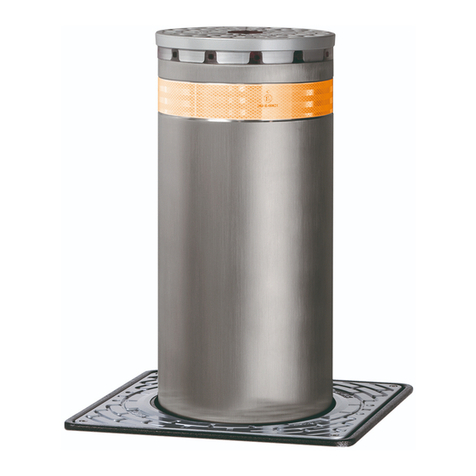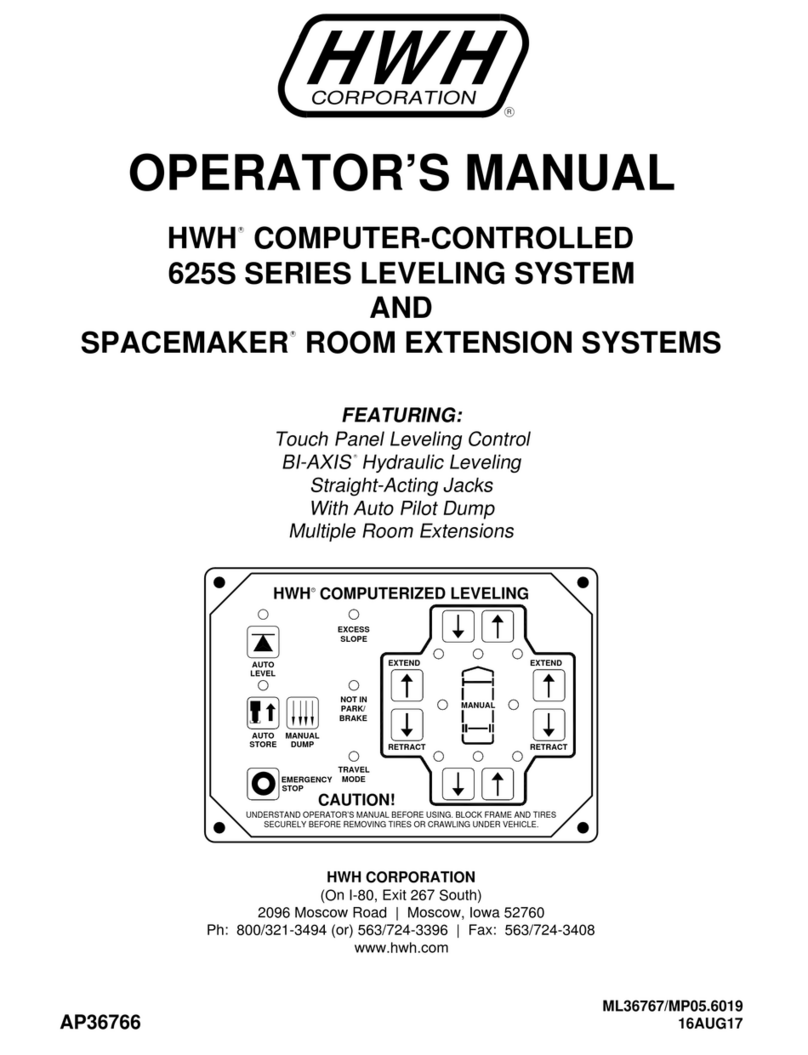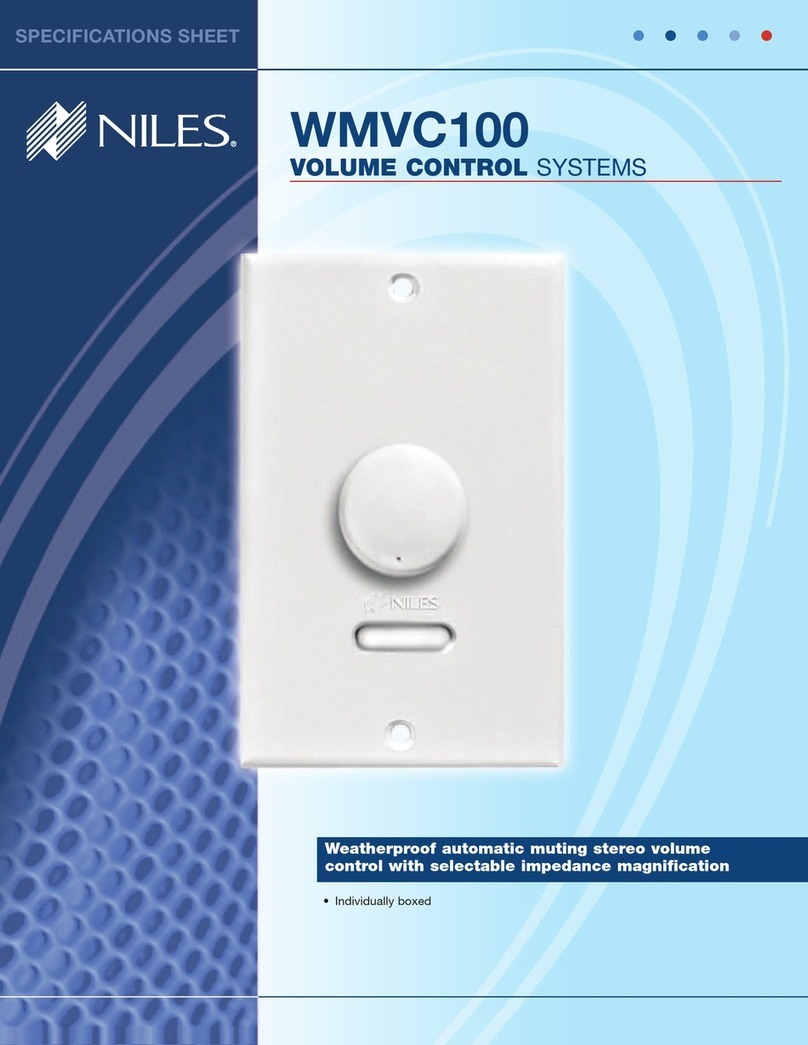Taylor Made Environmental Cruisair SMX II Guide

SMX II Control Systems (DX)
English
❖
INSTALLATION • OPERATION
Revised: 12-17-02
L-2066
LP-11
DIRECT EXPANSION SYSTEMS
For Direct Expansion SMX II Control Systems using these displays:

2❖❖
❖❖
❖English
L-2066
Table of Contents
This manual replaces manuals L-0634 and L-0503.
SMX II Control Systems • Introduction
Introduction ........................................................................ 3
SMX II Control Systems • Installation
Installing the SMX Keypad/Display .................................... 4
Installing the Power/Logic Box
(retrofit only) .................................................................... 4
Installing the Temperature Sensor
(remote systems and retrofit only) .................................. 4
SMX Interconnect Cable - Connecting
Keypad/Display To Power/Logic Board ............................ 5
Pressure Switches (retrofit only) ........................................ 5
SMX II Control Systems • Operation
The SMX Keypad/Display .................................................. 6
The SMXir Remote Control ................................................ 7
Basic Operation 8
Power On ........................................................................... 8
System Off ......................................................................... 8
Selecting Setpoint .............................................................. 8
Displaying Temperature ...................................................... 8
Cool Mode .......................................................................... 8
Heat Mode ......................................................................... 8
Automatic Changeover....................................................... 8
Manual Fan Speed Control ................................................ 8
Automatic Fan Speed Control ............................................ 8
Adjusting Brightness .......................................................... 8
Using The Humidity Control Routine.................................. 9
Anti-Ice Routine ................................................................. 9
Seawater Temperature and Your Cruisair System ............. 9
Programming the SMX II System 9
Factory Memory Reset ...................................................... 9
Programming Summary Table ......................................... 10
Custom Programming Record ......................................... 10
Compressor Time Delay .................................................. 11
Fahrenheit/Celsius Display ............................................... 11
Compressor Differential ................................................... 11
Fan Response Differential................................................ 11
Low Fan Speed Adjustment ............................................. 12
High Fan Speed Adjustment ............................................ 12
Fan Mode ......................................................................... 12
AC Line Voltage Calibration ............................................. 12
Temperature Calibration ................................................... 13
Humidity Control Program 13
Programming The Time Period ........................................ 13
Programming The Dehumidification Time ........................ 13
Recommended Humidity Control Settings ...................... 13
Fault Shutdowns and Error Messages 14
Fault Codes ...................................................................... 14
High Pressure Shutdown ................................................. 14
Low Pressure Shutdown .................................................. 14
Old Low Pressure Shut-Down
(Models before March 1998) ......................................... 14
Low Voltage Shutdown ..................................................... 14
Software Error .................................................................. 15
Determining Your Software Version Number ................... 15
Quick SMX II Troubleshooting Guide ............................... 15
Owner’s Limited Warranty 16
Cruisair and Sentry Limited Warranty 18
Description of Figures 19
Cruisair Dealer Locator 31

3❖❖
❖❖
❖English
L-2066
Warning
This manual contains essential information concerning
the installation and operation of your SMX II control
system. It is very important that you read and under-
stand the contents of this manual before using the
equipment, and it should be kept on the boat for future
reference. If you have any questions about the con-
tents of this manual, contact your local Cruisair dealer
or the Taylor Made Environmental Service Department
for assistance.
Introduction
This manual covers the installation and operation of
Cruisair SMX II computerized controls for direct expansion
(DX) marine air conditioning systems. There are many
different parts required for a complete installation, so make
sure that you have all the necessary items when installing
the system.
Two different keypad/displays are available for use with
SMX II control systems. The original SMX II keypad/display
is rectangular and requires a large cutout in the mounting
surface. The SMXir keypad/display has a compact housing
with a decorative hinged cover, and is surface-mounted. An
optional remote control can be used with the SMXir keypad/
display. Hereinafter, this manual will refer to the original
SMX II keypad/display as SMX II. The terms keypad and
display are interchangeable.
Before installing the system, please read the warnings in
this manual.
If you have an SMX Net control system, refer to manual(s)
LP-25,
SMX Net Control Systems (DX) Installation and
Operation.
SMX II Control Systems • Introduction

4❖❖
❖❖
❖English
L-2066 Installation
SMX II Control Systems • Installation
Warning
Make sure all power is off before opening any
electrical box.
Installing the SMX Keypad/Display
To be operated satisfactorily, the SMX keypad/display
should be installed so it is both visible and accessible. It
should be placed in plain view and within easy reach of the
operator. Overhead locations are discouraged since they
make it very difficult to use the SMX control.
Select a spot on an interior, vertical surface. This can be an
inside or outside wall, partition or other permanent struc-
ture with rear access for wiring. The SMX control operates
on low voltage DC and is certified ignition-protected. The
space behind the SMX control does not have to be venti-
lated since the control components do not produce heat.
SMX II Only
The SMX II keypad/display requires a cutout of 2
9
/
16
" x 7
1
/
8
"
(65mm X 181 mm). (For SMXir keypad installation, refer to
drawing #086800 in the back of this manual.)
After cutting the hole for the keypad control, make sure it
fits and the printed circuit board is clear of the bulkhead
and that no objects of any kind are in a position to contact
the SMX circuitry. Plug the interconnect cable in and route it
to the Power/Logic (P/L) box. Refit the control in the hole
and secure it with four No. 6 x
3
/
8
inch screws. Hook the
decorative plastic cover at the top, press it flat from the top
down, and snap it in place at the bottom.
Retrofitting SMXir Keypad/Display to
Original SMX II or 3-knob
Adapter plates are available to cover the old vertical or
horizontal rectangular cutout and mount the SMXir keypad/
display. Part #5103612 is a black plate, and #5103612W is
white. Use adapter #4163805 to connect an existing CX
cable to the SMXir display. (Refer to the SMXCABLE
drawing, Figure 9, at the back of this manual.)
Installing the Power/Logic Box
(retro it only)
All SX and FX systems with integrated SMX II controls have
the P/L box already installed on the unit.
In selecting a location for the Power/Logic box, bear in mind
that several sets of wires will be connected to it. Refer to
installation diagrams in this packet.
•The SMX P/L board is ignition protected, enclosed, and
operates in ambient temperatures up to 130°F (54°C).
•The P/L box may be installed in any position.
•The P/L board dissipates heat when operating, and must
be installed in a ventilated location.
•The P/L box is NOT waterproof and must be placed
where it will NOT get wet.
The power input to the board can be 115V or 230V. The
board automatically adjusts to either voltage.
Installing the Temperature Sensor
(remote systems and retro it only)
The TSEP temperature sensor measures the cabin air
temperature and relays the information to the power/logic
board. The sensor is 1" long by ¼" diameter (25mm x 7mm
diameter) and is attached to a length of flat, 4-conductor
cable with a RJ-11 phone type plug at the end. Different
lengths of TSEP cables are available, from 2 feet to 80 feet
(.6m to 24m).
For best results, the sensor should be placed in the return
air path, away from the system evaporator coil. Directly
behind the return air grill is often a good location. The
sensor must not touch the evaporator coil, or be placed in
the discharge air.
With the TSEP in the return air path, use the default mode
of continuous fan operation for the most accurate tempera-
ture control. If intermittent fan operation is desired (fan on
and off with the compressor), the sensor must be wall
mounted on an INSIDE surface not subject to any influence
from heat outside of the area (including direct sunlight).
Thermistor covers are available from Taylor Made Environ-
mental, Inc. for wall mounting.
SX self-contained units with integrated SMX II P/L box will
have the TSEP already installed. On FX remote units, the
TSEP must be run from the P/L box on the FX unit to the
return air path of the cooling unit.
The TSEP cable plugs into the RJ-11 jack on the P/L board
marked “INSIDE TSE”. Coil up any excess cable, and tie out
of the way.

5❖❖
❖❖
❖English
L-2066 Installation
If you have a P/L board manufactured before 2000, you
might have a 3-pin TSE plug. Adapters are available to
connect the new TSEP cables to the old P/L boards. Refer
to the SMXCABLE diagram at the back of this manual.
SMX Interconnect Cable - Connecting
Keypad/Display To Power/Logic Board
Connection between the SMX II keypad and the Power/
Logic board should be made with a CX## cable. This is a
shielded, 3-conductor cable with 4-pin plugs on each end.
The plugs on each end of the cable are identical, and are
polarized. Make sure all 4 pins are engaged in the plug.
Systems with the SMXir keypad should use a CXP## cable.
These are flat cables with RJ-12 phone jack plugs on each
end.
Both CX and CXP cables are available in different lengths,
from 2 feet (.6m) to 80 feet (24m). Route the cable from the
power/logic board to the keypad. Plug the cable in at both
ends, and secure per low DC voltage standards.
Warning
The SMX interconnect (CX or CXP) and temperature
sensor cables (TSEP) transmit low voltage DC signals,
and outside interference can affect their operation. Do
not route these cables beside A/C power cables, high
voltage wiring, or antenna wires. Keep the cable runs as
short as possible to reduce the chance of interference.
Note
Standard phone cable will not work with SMX controls.
Pressure Switches (retro it only)
Standard SX and FX units that have an integrated SMX II
P/L box include both the high and low pressure switches,
already connected. The SMX P/L board to pressure switch
signals are low voltage DC, and connections can be made
with 22 gauge or larger wire.
High-Pressure Switch: A high-pressure switch must be
connected to the SMX P/L board. Most marine A/C units
have a high-pressure switch that can be used for the SMX
switch. It should be disconnected from its in-line application,
and connected to the SMX P/L board at the push-on
terminals labeled “HIGH PRESS”.
The wires that were connected to the high-pressure switch
should then be butt connected together, effectively bypass-
ing the switch. The SMX II control will now monitor the
switch and shut the unit down if a high-pressure fault is
sensed.
Low-Pressure Switch: A low-pressure switch is recom-
mended for SMX controlled systems, but is optional if the
original unit did not have a low-pressure switch.
To add a low-pressure switch, use Cruisair model A-201,
and either the A-204 sweat in TEE kit for remote condens-
ing units or the #4024100 service port TEE kit for ¼" flare
ports, such as on SH self-contained units.
Connect the wires from the low-pressure switch to the SMX
P/L board at the terminals labeled “LOW PRESS”.
If an existing low-pressure switch is used, bypass the switch
by butt connecting the old switch wires together.

6❖❖
❖❖
❖English
L-2066 Operation
The SMX Keypad/Display
The SMX II and SMXir keypad/displays are arranged for
logical operation. The button layouts on the SMX II and the
SMXir are similar, and the buttons perform the same
respective functions. See next page for keypad/display
diagrams.
1. Data Display
Large LED readout that provides indication of current
setpoint, temperatures, programmed values and error
messages.
2. Cooling Indicator
Lights when compressor is running in cooling mode.
3. Heating Indicator
Lights when compressor is running in heating mode.
4. Setpoint Indicator (SMX II Display Only)
Lights when setpoint is displayed. Off when inside
temperature is displayed.
5. SET Key
Press the SET key to display your currently selected
setpoint (the temperature you wish to maintain in the
cabin). The SET key also is used to dim the data display
readout.
6. UP-DOWN Keys
Press UP or DOWN to raise or lower the setpoint. Press
and hold keys for large changes. Note: if inside tem-
perature is displayed, touching the UP or DOWN key
will cause the setpoint to be displayed.
7. TEMP Key
Press once to display inside temperature. Press TEMP
twice, and the display will alternate between inside
temperature and setpoint. Press again to return to
inside temperature only.
Hint
You can display temperature in degrees Fahrenheit or Celsius.
8. OFF Key
Turns system off. Note that the data display remains on.
You can continue to adjust setpoint, display temperature
readings and activate the manual fan to circulate air
while the system is in the OFF mode.
9. Cool Mode Indicator
Lights when you press the COOL key to select the
cooling mode.
10. Heat Mode Indicator
Lights when you press the HEAT key to select the
heating mode.
11. COOL Key
Turns the system on in the cooling mode.
12. HEAT Key
Turns the system on in the heating mode.
Hint
Press both HEAT and COOL at the same time, and the sys-
tem will automatically switch between cooling and heating
mode. When in the automatic switchover mode, both the
COOL and HEAT indicators are lit.
13. Manual Fan Indicator
Lights when fan is running in manual mode.
14. SLOW-FAST Keys
Control fan speed when the fan is in the manual mode.
Pressing SLOW or FAST key when in automatic fan
mode will change the system into manual mode.
15. FAN Key
Selects manual or automatic fan control mode. Press
once to select manual control. Press FAN again to
select automatic fan speed control. In this mode, the
fan speed is controlled by the microprocessor as a
function of the difference between setpoint and inside
temperature.
16. Fan Speed Indicators
Row of five small LEDs below FAN key. Indicate the
current fan speed.
17. Inside Temperature Indicator (SMXir Display Only)
When illuminated, inside temperature is displayed.
When light is off, setpoint is displayed.
18. IR Receiver (SMXir Display Only)
Infrared remote receiver
19. Dehumid Key (Remote Control Only)
Changes system into the Humidity Control program.
20. Auto Switchover Key (Remote Control Only)
Places the system into automatic changeover mode, so
it will switch from cooling to heating as needed.
De initions
LED - Light Emitting Diode. An indicator light is used to de-
note mode or operating status.
Setpoint - The selected temperature you want to maintain in
the area being heated or cooled.
SMX II Control Systems •Operation

7❖❖
❖❖
❖English
L-2066 Operation
SMX II Keypad/Display
SMXir Keypad/Display
SMXir Remote Control
The SMXir Remote Control
The SMXir remote control keypad has the familiar layout of
the 10-button SMX keypad, and performs most of the same
functions. The remote can not be used to program settings.
Programming must be done at the keypad/display.
In addition to the standard keys, the SMXir remote also has
two quick-hit buttons that allow easy access to the humidity
control program and the automatic changeover mode.
The remote has three buttons that are not used on SMX II
systems. The Aux Heat, Aux Heat Auto Switchover, and the
Aux 1 buttons are for SMX Net systems only.
The SMXir remote control must be pointed at the SMXir
keypad/display, which has the IR remote receiver. The
remote will not work if the SMXir keypad/display has the
optional full coverage door and the door is closed.
See Figure 12 for SMXir Remote control angle and distance
range.

8❖❖
❖❖
❖English
L-2066 Operation
Basic Operation
Power On
When AC power is applied to the system at the circuit
breaker, the SMX microprocessor performs a self-check
and retrieves from permanent memory the last operating
configuration. This process takes about four seconds, after
which the system will begin operating just as it had been
when power was last turned off.
System O
Press the OFF key to turn the system off. Note that the
data display remains energized even when the system is
off. The fan can be turned on manually when the system is
in the off mode.
Note
The SMX has built-in protection against sudden power in-
terruptions. The system automatically stores the current
operating configuration in permanent memory every time
you make changes. (The new operation mode must be in
affect for 30 seconds before it is saved into permanent
memory.) When AC power is lost, the SMX system retains
these settings, and when AC power is restored it resumes
operation using the same settings as before.
Selecting Setpoint
Press the SET key and the current setpoint will be dis-
played. Press the UP or DOWN key to change the setpoint.
Displaying Temperature
To display cabin temperature, press the TEMP key. Press
TEMP twice for an alternating display of inside temperature
and setpoint. Press again to return to inside temperature
only.
Cool Mode
To enter the COOL mode, press the COOL key. The Cool
Mode Indicator will light to show that you have selected the
cooling mode.
The Cooling Indicator will be lit whenever the system is in
the cooling mode and the compressor is running. When the
compressor cycles off, the Cooling Indicator goes off, but
the Cool Mode Indicator stays on.
Heat Mode
Press the HEAT key to select HEAT Mode. The Heat Mode
Indicator will light to show that you have selected the
heating mode.
The Heating Indicator will be lit whenever the system is in
the heating mode and the compressor is running. When the
compressor cycles off, the Heating Indicator goes off, but
the Heat Mode Indicator stays on.
Automatic Changeover
Press the COOL and HEAT keys simultaneously for
AUTOMATIC CHANGEOVER between COOL and HEAT
Modes. Both mode indicators will light, to show that the
system is in the automatic changeover mode.
For the SMXir Remote Control only - Press the Auto
Switchover key to enter automatic changeover mode.
Note that the Cooling or Heating Indicator will come on
when the compressor is running to show when the system
is running in the cooling or heating mode.
Manual Fan Speed Control
Press the FAN key to select manual fan control. The Manual
Fan Indicator will light to show that it is in the manual mode.
Then use the SLOW and FAST keys to select the desired
fan speed.
Note that you can use the manual fan control to circulate air
even when the system is in the OFF mode.
Automatic Fan Speed Control
If in manual fan mode, press FAN key to select automatic
fan control. The Manual Fan Indicator goes off, and the
system will automatically adjust fan speed as the cabin
temperature deviates from the setpoint. As setpoint is
approached, the fan speed automatically slows. Once
setpoint is reached, the compressor cycles off and the fan
keeps running on low speed.
Adjusting Brightness
Pressing the SET key repetitively will dim the LED display.
Keep pressing SET to return to full brightness.

9❖❖
❖❖
❖English
L-2066 Operation
Using The Humidity
Control Routine
When engaged, the SMX humidity control routine automati-
cally turns the air conditioning system on at timed intervals
to remove moisture from the air. The system is pro-
grammed at the factory for average values. To change the
factory settings, see “Humidity Control Program”.
To start the dehumidification program:
•Press OFF.
•Press COOL, HEAT and FAN keys simultaneously.
For the SMXir Remote Control only
- Press the
Dehumid key to enter dehumidification mode.
•The data display will flash HU, indicating that the
program is active.
•To halt the dehumidification program, press any key. The
HU message will stop flashing.
Sa ety Note
Whenever the SMX system is in the dehumidification mode,
all of the system safeguard controls remain active. If the
seawater flow fails or if line voltage falls below preset limits,
the system will automatically shut down. If AC power is in-
terrupted, the system will automatically resume operation in
the dehumidification mode when power is restored.
Anti-Ice Routine
The SMX control will occasionally shut down the compres-
sor in the cooling mode to allow any ice that may have
formed on the evaporator coil to melt. The anti-ice shut-
down only occurs at inside temperatures lower than 70°F
(21°C).
In a 10-minute cycle period, the compressor will shut off for
15 seconds per degree below 70°F. For example, if the
inside temperature is 67°F, the compressor will shut off for
45 seconds every 10 minutes.
Seawater Temperature and
Your Cruisair System
The basic principle behind an air conditioner or a heat
pump is the movement of heat. In an air conditioner, heat is
removed from the inside cabin and released to the seawa-
ter. In reverse-cycle heating, the refrigerant flow is reversed
and heat is extracted from the seawater and discharged
into the living space. The efficiency of the system operation
depends on both the seawater and cabin temperatures.
In cooling, the air conditioner will work best in seawater
temperatures below 90°F (32°C). At higher water tempera-
tures, the unit may work, but at reduced capacity. A high-
pressure shutdown can occur at higher water temperatures.
In heat mode, the opposite is true. As the water gets colder,
there is less heat available, and the heating performance
drops. Full heating capacity is obtained at about 55°F
(13°C). Performance drops to about 50% of rated capacity
in 40°F (4.4°C) water. Below this, the system pressure can
be so low that the unit will shut down on low-pressure fault.
This problem is compounded when the cabin is cold also.
The low pressure shutdown routine is such that the unit will
try many times to heat up the cabin enough to raise system
pressure and continue running.
Warning
Do not operate your A/C unit in water that is colder
than 38°F (3.3°C). Doing so could lead to water
freezing in the condenser coil which can cause
damage to the unit.
Programming the SMX II System
SMX control systems are programmed at the factory for
average values. For optimum performance, you may wish to
change these settings to suit your individual preferences.
All programming steps are entered by pressing the OFF
key, followed by the SET key, then simultaneously depress-
ing the two or three keys noted in the table below. Success-
ful entry into a programming mode is indicated by the
presence of a decimal point to the right of the two displayed
characters. To raise or lower a value, touch the UP or
DOWN keys. To exit the programming mode, touch the OFF
key. (The SMXir Remote Control can not be used to
program the system.)
Factory Memory Reset
You can use the memory-reset sequence to restore all
programmed functions to the factory default settings.
To restore programmed functions to factory setting:
•Press OFF, SET and FAN simultaneously.
•Press SET.
•After a delay, the memory will be reset from stored
values. After another delay, the display will come back on
normally.

10 ❖❖
❖❖
❖English
L-2066 Operation
Programming Summary Table
Custom Programming Record
Use table below to keep track of any program changes. If a Factroy Memory Reset is performed, then all parameters will revert
back to factory default settings as outlined in the Programming Summary Table above.
Programmable Function Keystroke Combination Factory Setting Range
Factory Memory Reset OFF & SET & FAN, then SET See table below before reset
Compressor Time Delay DOWN & SET & UP 0 0 to 70 sec.
Fahrenheit/Celsius DOWN & TEMP & UP F F or C
Compressor Differential SLOW & FAN 12 4 to 24
Fan Response Differential COOL & SLOW 4 2 to 8
(SLOW & FAN & FAST Before 8/98)
Low Fan Speed DOWN & SET 32 30 to 56
High Fan Speed SET & SLOW 60 41 to 90
Fan Mode (Cont. or Int.) DOWN & FAN & UP C C or I
AC Line Voltage Calibration DOWN & UP - ± 1%
Temperature Calibration SET & UP - ± 1%
HU Precirculation TEMP & DOWN 10 Min. 10 Min.
HU Dehumidification TEMP & SET 30 Min.
HU Time Period TEMP & UP 12 Hrs.
See “Humidity
Control Program”
Unit Location
(Cabin #, Salon, etc.)
Programmable Function Unit 1 Unit 2 Unit 3 Unit 4 Unit 5 Unit 6 Unit 7
Fahrenheit/Celsius
Auxiliary (Electric) Heat
Setpoint Differential
Fan Mode (Cont. or Int.)
Low Fan Speed
High Fan Speed
Fan Response Differential
HU Dehumidification
HU Time Period

11 ❖❖
❖❖
❖English
L-2066 Operation
Compressor Time Delay
(Factory Default: 0 seconds)
This function is used when you have more than one unit on
board. To prevent electrical overload due to multiple
compressors starting when turning on power to the system,
or when power is interrupted, each SMX unit should be
programmed with a different time delay.
Time delay can be set in increments of 1 second. On older
systems (before 8/98) the time delay is set in 10-second
increments, up to 70 seconds.
To program time delay, go to each SMX switch, and follow
these steps:
•Enter the programming mode: Press OFF, Press SET
•Press DOWN, SET and UP simultaneously. The delay in
seconds will be displayed.
•Use the UP or DOWN keys to change the time to the
desired setting.
•Press OFF to exit the programming mode.
At initial power-up, you will see the countdown for each
compressor on the data display, if you are in the TEMP
mode. The countdown will not appear in the SET mode.
Fahrenheit/Celsius
Display
(Factory Default: Fahrenheit)
You can choose to view temperature in degrees Fahrenheit
or Celsius.
To select Fahrenheit or Celsius:
•Enter the programming mode: Press OFF, Press SET
•Press DOWN, TEMP and UP simultaneously.
•Use the UP or DOWN key to select F for Fahrenheit or C
for Celsius.
•Press OFF to exit programming mode.
Note
If you switch from Fahrenheit to Celsius for temperature
displays, the compressor restart differential will also oper-
ate on degrees Celsius. Thus, the factory-set compressor
restart differential will be 1.5°Celsius, which is too wide. To
correct this, reset the differential value from 12 to 6. This
will provide a differential of 0.75°C, or about 1.4°F.
This will also affect the Fan Response Differential, which is
factory set at a value of 4, or 0.5°Fahrenheit. When chang-
ing from Fahrenheit to Celsius, you should reset the Fan
Response Differential from 4 to 2. This will provide a fan
differential of 0.25°C, or about 0.5°F.
Compressor Di erential
(Factory Default: 12 = 1.5°)
The compressor differential is the temperature change
needed for the compressor to cycle on and off. The factory
setting of 1.5°Fahrenheit should be adequate for most
applications. Differential selections are available in incre-
ments of 1/8°. Thus, to select one degree, you should
choose 8 (for 8-eighths).
To program the compressor differential:
•Enter the programming mode: Press OFF, Press SET
•Press SLOW and FAN simultaneously. The restart
differential will be displayed.
•Use the UP or DOWN key to change the setting.
•Press OFF to exit the programming mode.
Hint
Be careful not to set your compressor restart differential too
low, since it will cause the compressor to start and stop
quite often. This will place an undue load on your electrical
system and also wear out your compressor faster.
Fan Response Di erential
(Factory Default: 4 = 0.5°)
When the fan is in the automatic mode, its speed is
governed by how far the room temperature differs from the
setpoint. The fan runs faster when the difference is great.
As the room cools or warms, the temperature approaches
setpoint, and the fan slows down automatically. The amount
of temperature rise in the room above setpoint needed to
cause the fan to increase in speed one step is called “fan
speed differential”. It can be adjusted from 1/4°to 4°, in
1/8°increments.
The fan speed range is divided by the SMX microprocessor
in five equal increments. If the fan response differential is
set at 1/2°, the fan speed will change 20% for each 1/2°of
temperature deviation from setpoint. Lowering the fan
speed differential will cause the fan to increase speed
quickly as temperature changes. Raising the fan speed
differential will result in slower fan speed changes for a
given temperature change. The factory setting of 1/2°
Fahrenheit is good for most applications, but you may wish
to try a slightly higher setting in your salon and a lower
setting in your stateroom.
To adjust fan response differential:
•Enter the programming mode: Press OFF, Press SET
•Press COOL and SLOW. The differential will be displayed
in increments of 1/8°.
•Use the UP or DOWN key to raise or lower this value.
•Press OFF to exit the programming mode.

12 ❖❖
❖❖
❖English
L-2066 Operation
Note
On SMX II systems built before 8/98, press SLOW, FAN and
FAST simultaneously to adjust fan response differential.
Low Fan Speed Adjustment
(Factory Default: 32)
You can adjust the lowest fan speed to suit individual
preferences. For instance, you may wish to decrease the
low fan speed setting in your stateroom to minimize fan
noise.
To adjust low fan speed:
•Enter the programming mode: Press OFF, Press SET
•Press DOWN and SET simultaneously. The current low
speed reference number will be displayed (factory set
at 32).
•Press UP or DOWN to raise or lower speed reference
number.
•Press OFF to exit the programming mode.
Hint
You should normally keep the low fan speed at the highest
possible setting, consistent with a comfortable noise level,
for most efficient operation of your Cruisair system. Run-
ning the fan speed too slow can damage the compressor.
High Fan Speed Adjustment
(Factory Default: 60)
A blower will often reach its highest speed at a voltage
lower than full line voltage. For example, at a line voltage of
120V, the blower might reach its fastest speed at 110V. At
higher voltages, the bower speed will not increase signifi-
cantly.
The SMX High Fan Speed Adjustment allows you to set the
maximum high-speed voltage to the threshold of the blower
high-speed response. Because SMX breaks up the fan
speed voltage steps into 5 equal parts (between the low-
speed and high-speed adjustments), accurately setting the
high-speed adjustment can help ensure that each fan
speed step results in a noticeable change of fan speed.
To adjust the high fan speed:
•Enter the programming mode: Press OFF, Press SET
•Press SET and SLOW simultaneously. The current high-
speed reference number will be displayed (factory default
is 60).
•While listening to the fan noise level, use the UP key to
raise the displayed value past the point that you can hear
an increase in the fan noise level.
•Press the DOWN key to lower the voltage until you hear
a drop in fan speed, then raise that number up by 2 or 3
to ensure that it is set at the highest speed.
•Press OFF to exit the programming mode.
Fan Mode
(Factory Default: Continuous)
You can select continuous fan operation or instruct the fan
to cycle on and off with the system compressor.
To select continuous or intermittent fan:
•Enter the programming mode: Press OFF, Press SET
•Press DOWN, FAN and UP simultaneously.
•Use the UP or DOWN key to select C (continuous) or
I (intermittent).
•Press OFF to exit the programming mode.
Hint
If you select intermittent fan operation, you should relocate the
thermistor from the return air duct to an inside wall to best
sense room temperature. Check with your dealer or call the
Cruisair Applications Department for more information.
AC Line Voltage Calibration
The SMX control assembly has a built-in voltmeter that
senses AC line voltage. The microprocessor automatically
responds to sustained low-voltage conditions by shutting
down the air conditioning system to prevent compressor
damage.
At installation, the SMX voltmeter is calibrated to line
voltage within +/- 1%.
To check or recalibrate AC line voltage:
•Enter the programming mode: Press OFF, Press SET
•Press DOWN and UP simultaneously. Line voltage will be
displayed in 2 digits. On 115V systems, 95V appears as
95, 100V as 00, and 120V as 20. For 230V systems the
reading shows 1/2 of line voltage, therefore, 190V will
appear as 95, 200V as 00, and 230V as 15.
•To check accuracy or to calibrate, turn off all on-board
AC loads and measure the line voltage with an accurate
voltmeter.
•If the SMX displayed voltage is not correct, press the UP
or DOWN key to enter the correct value.
•Press OFF to exit the programming mode.

13 ❖❖
❖❖
❖English
L-2066 Operation
Temperature Calibration
Typically, the temperature sensor is within 1 or 2 degrees of
actual room temperature. If off by more, it can be calibrated
to read actual temperature.
To calibrate the thermistor:
•Enter the programming mode: Press OFF, Press SET
•Press SET and UP simultaneously. The sensed tempera-
ture will be displayed.
•Place an accurate thermometer beside the thermistor
you are using and compare the temperatures.
•Use the UP or DOWN key to adjust the displayed
temperature to the correct value.
•Press OFF to exit the programming mode.
Humidity Control Program
The SMX dehumidification program automatically runs the
air conditioning system for a programmed time period to
help control humidity in the boat. The dehumidification
program works in 3 stages:
The fan comes on at high speed to circulate air for 10
minutes.
The fan then drops to low speed, and the compressor
cycles on in the cooling mode to dehumidify.
After the dehumidification cycle, the system turns off. The
process repeats according to the programmed time period.
The compressor time delay setting will affect when the
dehumidification cycle starts. Every 1-second of compres-
sor delay equals a 6-minute advance into the dehumidifica-
tion cycle. This can cause the dehumidification cycle to skip
the first running and wait until the next time period.
The factory default settings are:
Overall time period ......................... 12 hours
Precirculation cycle ........................ 10 min.
Dehumidification cycle ................... 30 min.
The factory settings are adequate for most moderate
climates and boats. For humid climates, you may wish to
shorten the overall time period and extend the dehumidifi-
cation time. In dry climates, you can select longer intervals
between cycles and a shorter dehumidification time.
Programming The Time Period
(Factory Default: 12 hours)
The time period determines how often the system performs
the dehumidification process. You can select intervals of 2,
4, 6, 8, 10, 12, 14 or 16 hours. Chose a shorter time period
in climates with high humidity.
To select time period:
•Enter the programming mode: Press OFF, Press SET
•Press TEMP and UP simultaneously. The display will
show the overall time period in hours.
•Use the UP or DOWN key to select the desired time
period.
•Press OFF to exit the programming mode.
Programming The
Dehumidi ication Time
(Factory Default: 30 minutes)
The dehumidification time determines how long the com-
pressor runs in the dehumidification mode. You can select
10, 20, 30, 40, 50 or 60 minutes. Select a longer dehumidi-
fication time in humid climates.
To select dehumidification time:
•Enter the programming mode: Press OFF, Press SET
•Press TEMP and SET simultaneously. The display will
show the time period in minutes.
•Use the UP or DOWN key to select the desired time
period.
•Press OFF to exit the programming mode.
Recommended Humidity Control Settings
Outside Relative Time Dehumid.
Temperature Humidity Period Time
Below 80°F 75-85% 12 hrs 10 min
(27°C) Above 85% 8 hrs 20 min
80°- 90°F 75-85% 10 hrs 30 min
(27°- 32°C) Above 85% 6 hrs 40 min
Above 90°F 75-85% 8 hrs 40 min
(32°C)
Above 85% 6 hrs 60 min

14 ❖❖
❖❖
❖English
L-2066 Operation
Cooling Mode:
When the LP switch first opens, the unit will run for 2
minutes, then shut down for 50 seconds. It will do this 4
times. If the switch has not closed, the unit will shut down
for 15 minutes, and flash “LO PS”on the display. After 15
minutes of shut down, the 2 minutes on, 50 seconds off
cycle starts again.
If, after 18 attempted compressor starts, the low-pressure
switch does not stay closed, the unit will go into a sustained
shutdown and flash “LO PS”.
If the LP switch closes at any time before the sustained
shutdown, the unit will then operate normally.
Heating Mode:
If the LP switch opens, the fan will automatically change to low
speed to try and raise system pressure. It will run for 11
minutes in this mode. Note that the fan speed can not be
adjusted at this time. Any attempt to raise fan speed will result
in “LO PS”being flashed, while the unit continues to run.
After 11 minutes, the unit will run for 2 minutes, then shut
down for 50 seconds. It will do this 4 times. If the switch has
not closed, the unit will shut down for 15 minutes, and flash
“LO PS”on the display. After 15 minutes of shut down, the
2 minutes on, 50 seconds off cycle starts again.
If, after 18 attempted compressor starts, the low-pressure
switch does not stay closed, the unit will go into a sustained
shutdown and flash “LO PS”.
If the LP switch closes at any time before the sustained
shutdown, the unit will then operate normally.
Old Low Pressure Shut-Down
(Models be ore March 1998)
The low-pressure shut down fault program was different on
units built before March to May of 1998. On the early units,
if the low-pressure switch opens (suction pressure drops
below 35 psi) and stays open for 2 minutes, the unit will
shut down. If the pressure rises and the switch closes, the
unit will restart. It will attempt 5 restarts, and then go into a
sustained shut down, flashing LO - PS. Press the OFF key
to reset the system.
Low Voltage Shutdown
The low-voltage protection feature is always active. If AC
line voltage drops and remains below 100 volts (200 volts
for a 230V system) for more than three minutes, the SMX
shuts down the entire system. The display will flash LO-AC
(for low AC). This is a sustained shutdown, and the system
will not resume operation even if the line voltage rises to
normal levels. To reset, press the OFF key.
Fault Shutdowns and Error Messages
The SMX control contains built-in safeguards designed to
protect your air conditioning system from damaging
conditions. These are described below.
Hint
Your system must be equipped with a high-pressure switch
and low-pressure switch for the high- and low-pressure shut-
down to operate. You should check with your dealer to make
sure these important protective devices are installed properly.
Fault Codes
If an operational failure occurs, the display will flash one of
the following fault code messages. Fault code displays are
cancelled by pressing OFF.
High Pressure Shutdown
In the cooling mode, if head pressure rises above 400-425
PSI (usually caused by loss of cooling water flow, refriger-
ant gas overcharge or dirty condenser) the SMX will
attempt three restarts, then shuts down the entire system.
The display will flash the legend HI-PS (for high pressure).
This is a sustained shutdown, and even when the pressure
falls after shutdown, the system will remain off until reset by
pressing the OFF key.
In the heating mode, a rise in head pressure above the set
limit (usually caused by poor airflow or incorrect charge) will
cause the compressor to cycle off for two minutes, allowing
the heat in the coil to dissipate. This readies the system for
recycling in the heating mode. The compressor will then
continue to cycle, based on input from the high-pressure
switch, until the cabin temperature reaches setpoint, after
which compressor cycling is automatically restored to
normal thermostatic control.
Low Pressure Shutdown
When installed, the low-pressure switch is monitored by the
SMX control. The low pressure switch opens when the
suction pressure drops below 30 psi, and resets at 45 psi.
The low-pressure fault routine operates differently in the
cooling and heat modes.
Fault Code Meaning Result
LO / AC Operating voltage remained Shutdown
below 100V for 3 min. (or 200V
for 230V system)
HI / PS* Head pressure above 425 PSI Shutdown
LO / PS* Suction Pressure below 30 PSI Shutdown
PE Program error in software Shutdown
* Note: The “PS”in the high pressure and low pressure fault
warning can be confused as “P5”on the SMX LED display

15 ❖❖
❖❖
❖English
L-2066 Operation
Hint
For the low voltage shutdown function to work properly, the
SMX internal voltmeter should be calibrated. This is nor-
mally accomplished at installation. To check or recalibrate
line voltage, see “Programming Summary Table”.
So tware Error
Whenever power is applied to the SMX, the microprocessor
goes through an automatic self-check and software loading
process. If all is well, the SMX loads the most recent
operating configuration from its internal memory, and turns
on normally. If a program fault is found during the self-
check, the error message PE will be displayed.
Likewise, the self-diagnostic routine runs continuously
whenever the SMX system is on. If a system fault is
detected, the system shuts down, and the PE error mes-
sage appears.
If this message occurs, contact your nearest Cruisair
dealer, or call the Factory Service Department in Rich-
mond, Virginia (804-746-1313) for assistance.
Determining Your So tware
Version Number
When you call your dealer or the factory for service assis-
tance, it’s helpful to know the Software Version Number for
your SMX system.
SMX II Systems (Before 8-1-98)
To display your software number:
•Press OFF.
•Press OFF, SET and FAN simultaneously.
•Press COOL twice until display reads 68.
•Press UP once. The display should read Version Number.
•Press SLOW until display reads F2.
•Press UP once. The display should read Revision Level.
All SMX Systems (After 8/98)
To display your software number:
•Press OFF, then SET.
•Then press COOL and DOWN simultaneously. The
display will read Version Number.
•Press UP once. The display should read Revision Level.
Quick SMX II Troubleshooting Guide
Problem: SMX Display Not On
Possible Solution:
1. Turn circuit breaker on
2. Check CX/CXP cable and connections
3. Replace keypad/display
4. Replace Power/Logic board
Problem: Erratic Temperature Display
Possible Solution:
1. Perform a Factory Memory Reset
2. Check temperature sensor, cable and connection
3. Ensure the temperature sensor is installed properly
4. Calibrate temperature
5. Replace Power/Logic board
Problem: Erratic system operation
Possible Solution:
1. Perform a Factory Memory Reset
2. Check CX/CXP cable and connections
3. Check temperature sensor, cable and connection
4. Replace keypad/display
5. Replace Power/Logic board
Warning
The Power/Logic board operates at 115VAC or
230VAC. Make sure the power is off before removing
the cover of the Power/Logic box.
Contact an authorized Cruisair servicing dealer if the
problem continues, or for replacement parts.

16 ❖❖
❖❖
❖English
L-2066
Owner’s Limited
WARRANTY
As hereinafter described, Taylor Made Environmental, Inc. limits the duration of any implied warranty to the duration of
the underlying express warranty and also disclaims any liability for consequential or incidental damages arising from
any application, installation, use or malfunction of any warranted product.
Section I
What does the Limited Warranty cover?
Products manufactured by Taylor Made Environmental, Inc.
(TME) are under limited warranty to be free from defects in
workmanship or materials under normal use and service
with the obligation of TME under this limited warranty being
limited to replacing or repairing any component(s) which
shall disclose defects within the time limits defined in
Section III and which, upon examination by TME, shall
appear to the satisfaction of TME to be defective or not up
to specifications.
This Limited Warranty is made in lieu of all other
express warranties, obligations, or liabilities on the
part of TME. In addition, TME shall not be responsible
for any incidental or consequential damages.
In those
instances in which a cash refund is made, such refund shall
effect the cancellation of the contract of sale without
reservation of rights on the part of the purchaser. Such
refund shall constitute full and final satisfaction of all
claims which purchaser has or may have against TME
due to any actual or alleged breach of warranty, either
express or implied, including, without limitation, any
implied warranty of merchantability or fitness for a
particular purpose. Some states do not allow the exclu-
sion or limitation of incidental or consequential damages so
the above limitation may not apply to you. The terms and
conditions of this warranty shall be governed by the laws of
the Commonwealth of Virginia.
The Dealer is not an agent for TME except for the purpose
of administering the above warranty to the extent herein
provided, and TME does not authorize the dealer or any
other person to assume for TME any liability in connection
with such warranty, or any liability or expense incurred in
the replacement or repair of its products other than those
expressly authorized herein. TME shall not be responsible
for any liability or expense except as is specifically autho-
rized and provided in this section.
TME reserves the right to improve its products through
changes in design or material without being obligated to
incorporate such changes in products of prior manufacture,
and to make changes at any time in design, materials, or
part of units of any one year's model, without obligation or
liability to owners of units of the same year's model of prior
manufacture.
This warranty gives you, the purchaser, specific legal rights,
and you may also have other rights which vary from state to
state. You also have implied warranty rights, including an
implied warranty of merchantability, which means that your
product must be fit for the ordinary purposes for which such
goods are used.
The duration of any implied warranty
rights is limited to the duration of the express warranty
as found in Section III.
Some states do not allow limita-
tions on how long an implied warranty lasts, so the above
limitation may not apply to you.
Section II
What does this Limited Warranty not cover?
This Warranty Shall Not Apply to:
1. Failures resulting from improper installation or use
contrary to instructions.
2. Failures resulting from abuse, misuse, accident, fire, or
submergence.
3. Any part manufactured by TME which shall have been
altered so as to impair its original characteristics.
4. Any parts which fail as a result of misuse, improper
application or improper installation.
5. Items not manufactured by TME, i.e., items which are
purchased from another manufacturer and supplied as
received by TME without alteration or modification
except as any part of an TME-manufactured unit or
component.
6. Components or parts used by or applied by the pur-
chaser as an integral part of products not manufactured
by TME.
Installation and application of TME components is not
warranted by TME because TME has no control or authority
over the selection, location, application, or installation of
these components.
Section III
What is the period of coverage?
See the previous section entitled Warranty Periods.
All TME components bear a data plate on which there are
model and serial numbers. The serial number is date coded.
To determine whether or not any TME component is in
warranty, proceed as follows:
Products Products

17 ❖❖
❖❖
❖English
L-2066
L-0123 Revised: 7-19-01
1. Determine the manufacture date of the component from
the serial number on the data plate. If you are not
familiar with the date code, write or call the TME
Customer Service Department at (804)746-1313, to
obtain the manufacture date. The hours of the Cus-
tomer Service Department are 8:00 am - 5:00 pm USA,
Eastern Time Zone) Monday through Friday excluding
holidays.
2. It is possible that there might exist a considerable time
lag between the date a component is manufactured and
the date it is put in service. In such instances, the date
of manufacture could indicate that the item is out of
warranty. However, based on the date the equipment is
first put in service, the item may still be covered by the
TME warranty described in Section I. For proof of date
put in service, TME will require a copy of the bill of sale
of the TME equipment from the installer or new boat
dealer to the original owner.
Section IV
How do you get service? Please Read the follow-
ing Warranty Procedure.
WARRANTY PROCEDURE
If the failure of a TME component is determined to be
covered under the TME warranty and the time in service is
determined to be within the warranty time limit, the owner
has the following three options:
1. Preferred option: Have an TME authorized Servicing
Dealer perform the work needed. The customer should
call TME's Service Department for a recommendation
as to the closest dealer. If the customer already knows
an authorized servicing dealer, the dealer should be
contacted directly.
2. If the customer contacts TME's Service Department for
a Servicing Dealer and TME has no one in that particu-
lar area, TME will authorize the use of a local service
company and TME will work with the local company to
assist in any way possible.
3. The customer may send his equipment back to the
factory to have the repair work done. TME will make
every effort to return the equipment to the customer
within a three week time period. If the claim represents
a legitimate warranty problem, TME will pay the freight
both ways. TME prefers option one and two, if at all
possible.
The customer may contact the TME Service Department at
(804) 746-1313.
W RNING
Taylor Made Environmental, Inc. (TME) manufacturers of Cruisair, Grunert, Marine
Air, Sentry and Tundra Products, makes the following safety warnings concerning
the application, installation, use and care of its products. Although these warnings
are extensive, there may be specific hazards which may arise out of circum-
stances which we have not outlined herein. Use this as a guide for developing an
awareness of potential hazards of all kinds. Such an awareness will be a key
factor in assuring your SAFETY and comfort.
ELECTRICITY - Many TME products operate on 115, 230 or 440 volt AC power.
Such voltages can be LETHAL; therefore, the chassis, cabinets, bases, etc., on all
components must be grounded together and connected to the vessel's grounding
system. Sparks can occur as switches, thermostats and relays open and close in
the normal operation of the equipment. Since this is the case, ventilating blowers
for the removal of hazardous fumes or vapors should be operated at least 5
minutes before and during operation of any TME product or group of TME
products. All electrical connections must be covered and protected so accidental
contact cannot be made by persons using the equipment, as such contact could
be LETHAL.
ELECTROLYSIS - Electrical leakage of any component can cause electrolytic
deterioration (electrolysis) of thru-hull components which could result in leakage
serious enough to sink a vessel which could result in loss of life. All TME
components must be kept clean and dry and checked periodically for electrical
leakage. If any electrical leakage is detected, the component should be replaced
or the fault causing the leakage corrected before the component is put back into
service.
GAS - CRUISAIR, MARINE AIR, GRUNERT and TUNDRA components utilize R-22
(Chlorodifluoromethane), R134a refrigerant (Tetrafluoroethane), R-407C (which
contains Diflouromethane (HFC-32), Pentafluoroethane (HFC125), and 1.1.1.2 -
Tetrafluoroethane (HFC134a)), or R404A (R125/R143a/R134 (44%/52%/4%))
which are non-toxic, non-flammable gases; however, these gases contain no
oxygen and will not support life. Refrigerant gas tends to settle in the lowest areas
of the compartment. If you experience a leak, evacuate all personnel, and
ventilate area. Do not allow open flames in the area of leaks because refrigerant
gas, when burned, decomposes into other potentially LETHAL gases. Refrigerant
components operate at high pressure and no servicing should be attempted
without gloves, long-sleeved clothing and eye protection. Liquid refrigerant gas
can cause severe frost burns to the skin and eyes.
VENTILATION - To cool or heat air, CRUISAIR, MARINE AIR and GRUNERT
components are designed to move air through a heat exchanger by a blower or
propeller fan. This design necessarily produces a suction on one side of the air
handling component and a pressure on the other side. Air handling components
must be installed so that the suction-pressure action does not: (1) pressurize an
area to the extent that structural failure occurs which could cause harm to
occupants or bystanders, or (2) cause a suction or low pressure in an area where
hydrogen gas from batteries, raw fuel vapor from fuel tanks, carbon monoxide
from operating propulsion engines, power generators or heaters, methane gas
from sewage holding tanks, or any other dangerous gas or vapor could exist. If an
air handling unit is installed in such a manner that allows potentially lethal gases
or vapors to be discharged by the air handling unit into the living space, this could
result in loss of life.
Maximum protection against the introduction of dangerous gases or vapors into
living spaces can be obtained by providing living spaces which are sealed from all
other spaces by use of airtight bulkheads and decks, etc., and through the
introduction of clean air into the living space. Bear in mind that the advent of air
conditioning, whether it be for cooling or for heating, naturally leads to the practice
of closing a living space tightly. Never close all windows and doors unless
auxiliary ventilating systems, which introduce clean outside air into the living
space, are used. Always leave enough window and door openings to provide
adequate ventilation in the event potentially lethal gases or fumes should escape
from any source.
CONDENSATE - All cooling units produce water condensate when operating on
the cooling cycle. This water must be drained from the cooling unit overboard. If
condensate is allowed to drip on a wooden structure, rotting or decay and
structural failure may occur which could result in loss of life. If condensate is
allowed to drip on electrical components, deterioration of the electrical compo-
nents could result in hazardous conditions. When an air conditioning system is in
operation, condensate drains may be subjected to negative pressure. Always
locate condensate drains as far as possible from points where engine waste and
other dangerous gases are exhausted so no such dangerous gases can be drawn
into the condensate drains.
Warning
Never sleep in a closed area on a boat when any equipment, which functions as a
result of the combustion of a volatile fuel, is in operation (such as engines,
generators, power plants, or oil-fired heaters, etc.). At any time, the exhaust
system of such devices could fail, resulting in a build-up of LETHAL gases within
the closed area. Warning Revised: 7-19-01

18 ❖❖
❖❖
❖English
L-2066
Cruisair and Sentry Limited Warranty
WARRANTY PERIODS
Please read and keep this document with your important paperwork. Use it as a reference in the future. If you have any
questions, please contact the Cruisair Service Department at (804)746-1313 for clarification.
Note: Any model or replacement part that has been installed due to a warranty failure will carry onlythe remainder of the
original warranty. All warranties begin when the customer takes possession of the equipment. The warranty is extended to all
owners of the equipment commencing the date the original owner takes possession of it. Proof of original purchase may be
required. Fuses and MOV’sare used as safety devices to protect Cruisair equipment against over-current conditions caused
by lightning or inductive switching environments. These are not covered under warranty. We reserve the right to change our
warranty policies and procedures as well as our warranty allowances without notice.
Cruisair Direct Expansion (DX)
and Modulating Systems
•New, complete system installation using any member of
the SMX family.
The warranty includes the pump.
2 year warranty including Parts and Labor
•New, complete system installation using an electro-
mechanical control (3-knob).
The warranty includes the pump.
1 year warranty including Parts and Labor
•New, complete model sold as a partial system retrofit to
an existing system.
Includes SMX family.
1 year warranty including Parts and Labor
Cruisair Tempered Water
•New, complete system installation using any member of
the SMX family.
2 year warranty including Parts and Labor
NOTE: Excludes pump which has a 1 year warranty
•New, complete model sold as a partial system retrofit to
an existing system.
Includes SMX family.
1 year warranty including Parts and Labor
Sentry Battery Chargers
•New SM or FR series installation.
2 year warranty including Parts and Labor
•New G-series installation.
1 year warranty including Parts and Labor
Cockpit Freezers/Re rigerators-Fish Boxes
•New installation of entire system including condensing
unit, line sets, evaporator, etc.
1 year warranty including Parts and Labor
•New complete model sold as a partial system retrofit to
an existing Cruisair system.
1 year warranty including Parts and Labor
•New installation of condensing unit only, with line sets,
evaporators, etc. done by others i.e. not Cruisair pre-
charged line sets and evaporators.
1 year warranty including parts and labor on
mechanical and electrical parts of condensing
unit only.
Replacement Parts
•Replacement parts and components - example: A-509,
40401-30.
90 day warranty, Parts only
•Replacement Compressors for other than Tempered
Water Systems - example: R3101-16T, DX equipment -
installed in an existing Cruisair system or a competitor’s
system.
1 year warranty including Parts and Labor
•Replacement compressors for Tempered Water -
example: 30130-36 installed in an existing Cruisair
system.
1 year warranty including Parts and Labor
•A Tempered Water compressor - example: 30130-36
installed with competitor’s equipment.
90 day warranty, Parts only
Revised: 10-17-02 L-0694

19 ❖❖
❖❖
❖English
L-2066
Description o Figures
Fig. 1 SXR7-16CK; 115/230V, 50-60Hz
Dwg No. 82570, P-967
Fig. 2 SX7-24CK; 115/230V, 50-60Hz
Dwg No. 082577, P-1023
Fig. 3 FX5-36CK; 115/230V, 50-60Hz
Dwg No. 083703, P-1048
Fig. 4 FX48RC; 230V, 50-60 Hz
Dwg No. 083704, P-1049
Fig. 5 FX20DC-FX48EC; 230V-460V, 3Ph, 50-60 Hz
Dwg No. 084901, P1050
Fig. 6 SMX II Retrofit, Typ. 3-knob
Dwg. No. 084001, P-1063, A-284
Fig. 7 SMX II Retrofit, F20C-48RC, to 3-knob term. strip
Dwg No. 082605, P-1065,A-279
Fig. 8 SMX II Retrofit, F20C-48RC, to cond. unit
Dwg No. 082606, P-106, A-279
Fig. 9 SMXCABLE; Cable Diagrams; Old and New P/L Boards
Fig. 10 SMXir Mounting Template and Instructions
Dwg No. 086800, P-1077
Fig. 11 Replacement DX SMX II Parts
Fig. 12 SMXir Remote Control Operation Range
Dwg No. SKA-1247-rev1

20
L-2066
Fig.1 - SXR7-16CK - 115/230V, 50-60Hz
This manual suits for next models
1
Table of contents
Popular Control System manuals by other brands

Siemens
Siemens DMS8000 Connectivity guide

Nordson
Nordson Eclipse EPC-30 Series instruction sheet
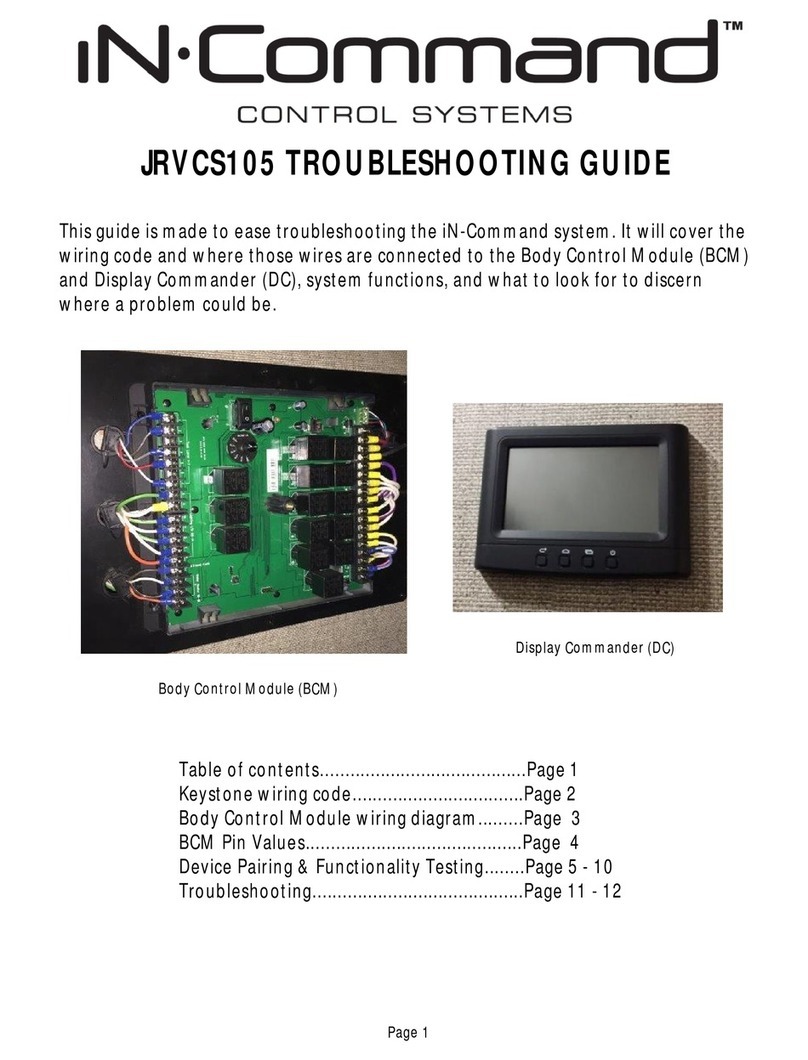
ASA Electronics
ASA Electronics iN-Command JRVCS105 troubleshooting guide
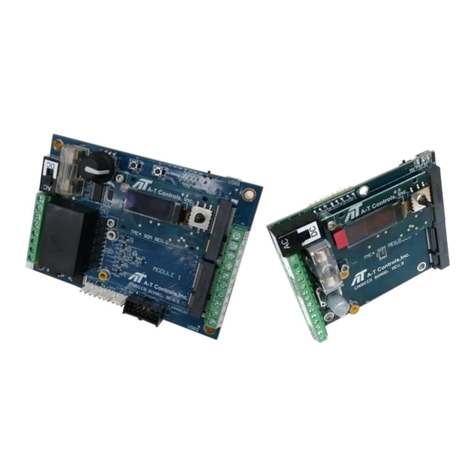
A-T Controls
A-T Controls TRIAO TMC-4 Installation and operation manual
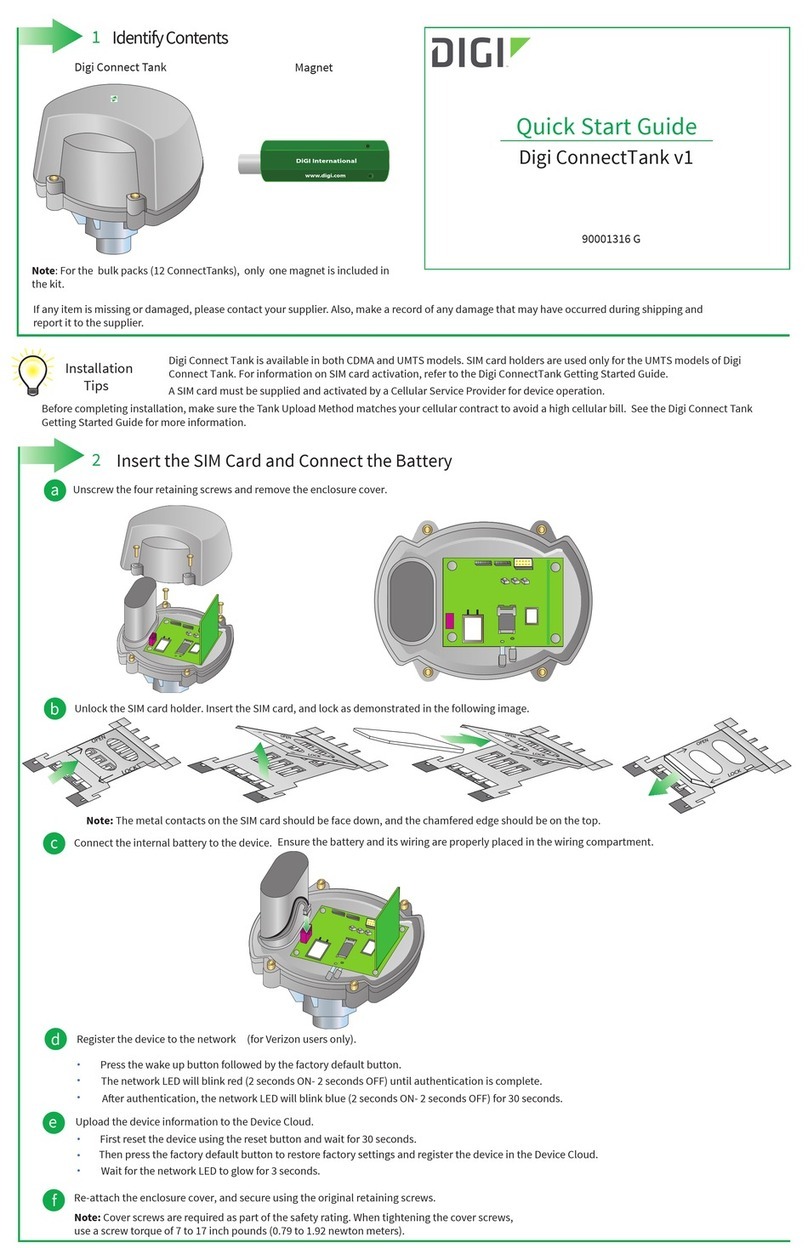
Digi
Digi ConnectTank v1 quick start guide
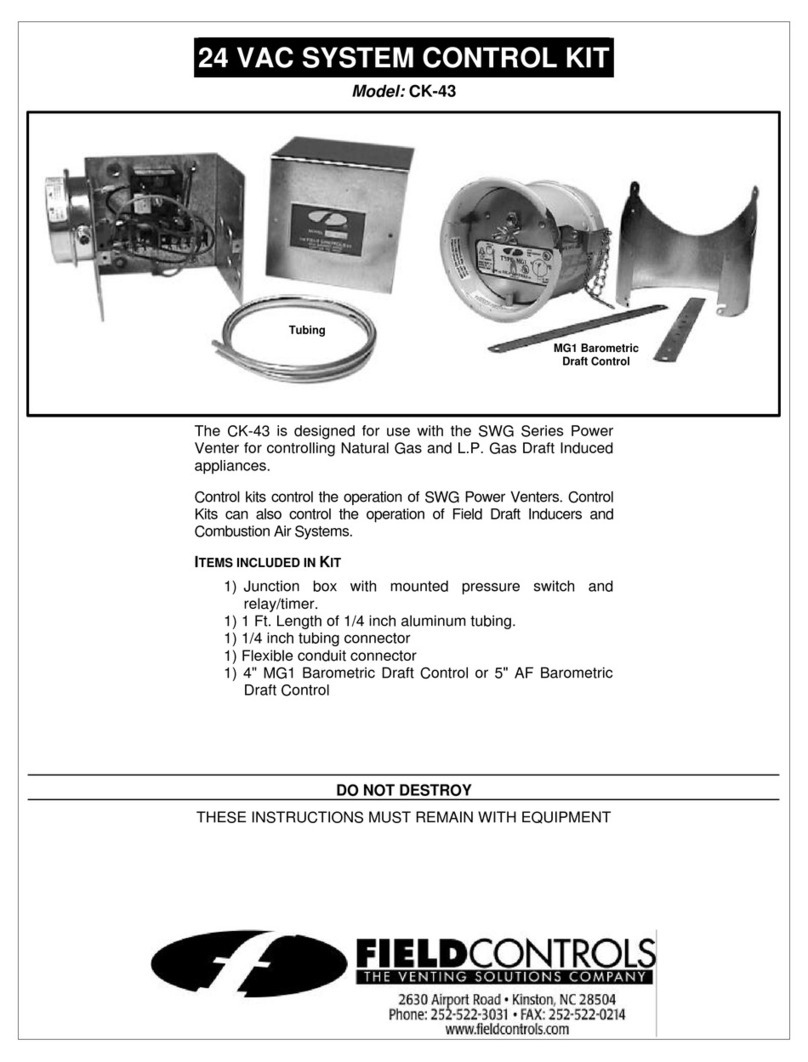
Field Controls
Field Controls CK-43 manual
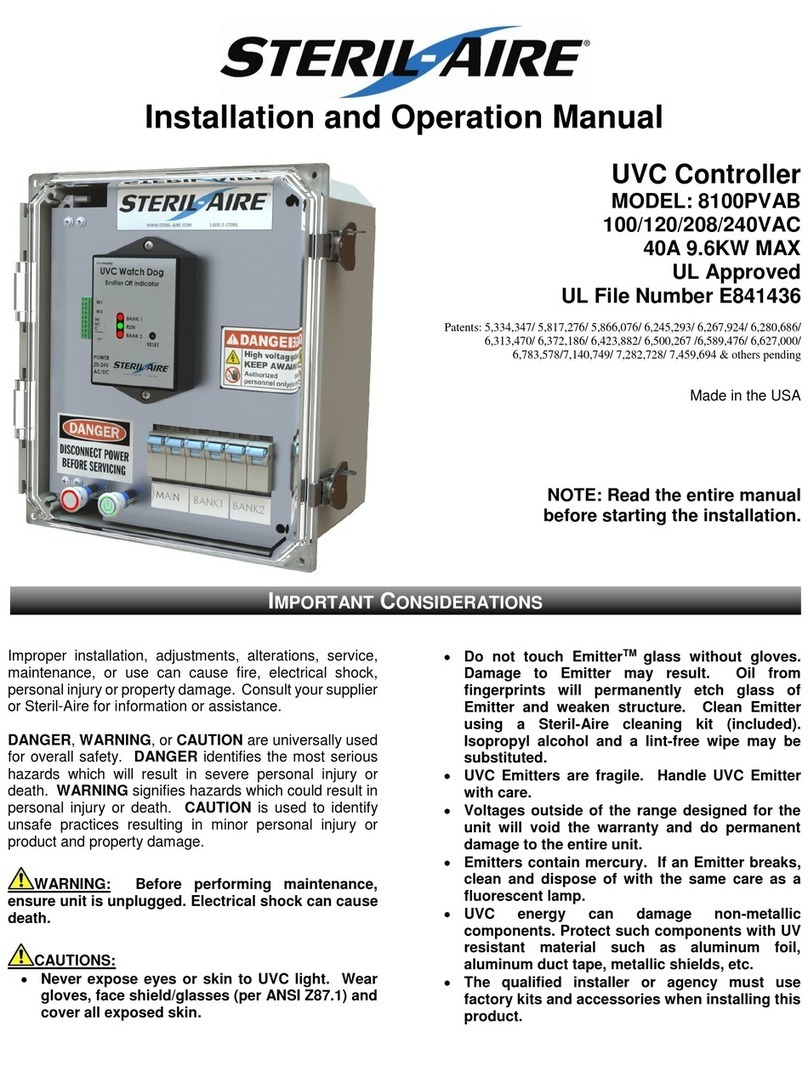
Steril-Aire
Steril-Aire 8100PVAB Installation and operation manual
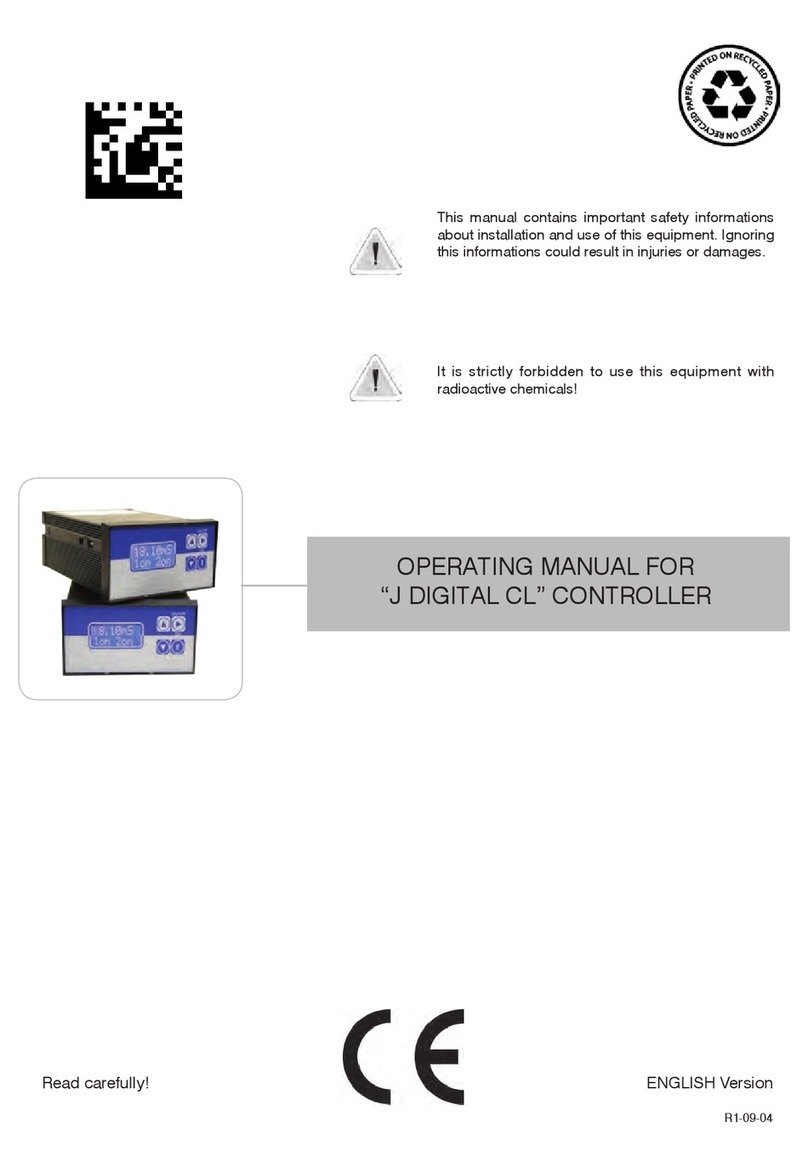
Emec
Emec J DIGITAL CL operating manual

Nordson
Nordson PowderPilot HD manual
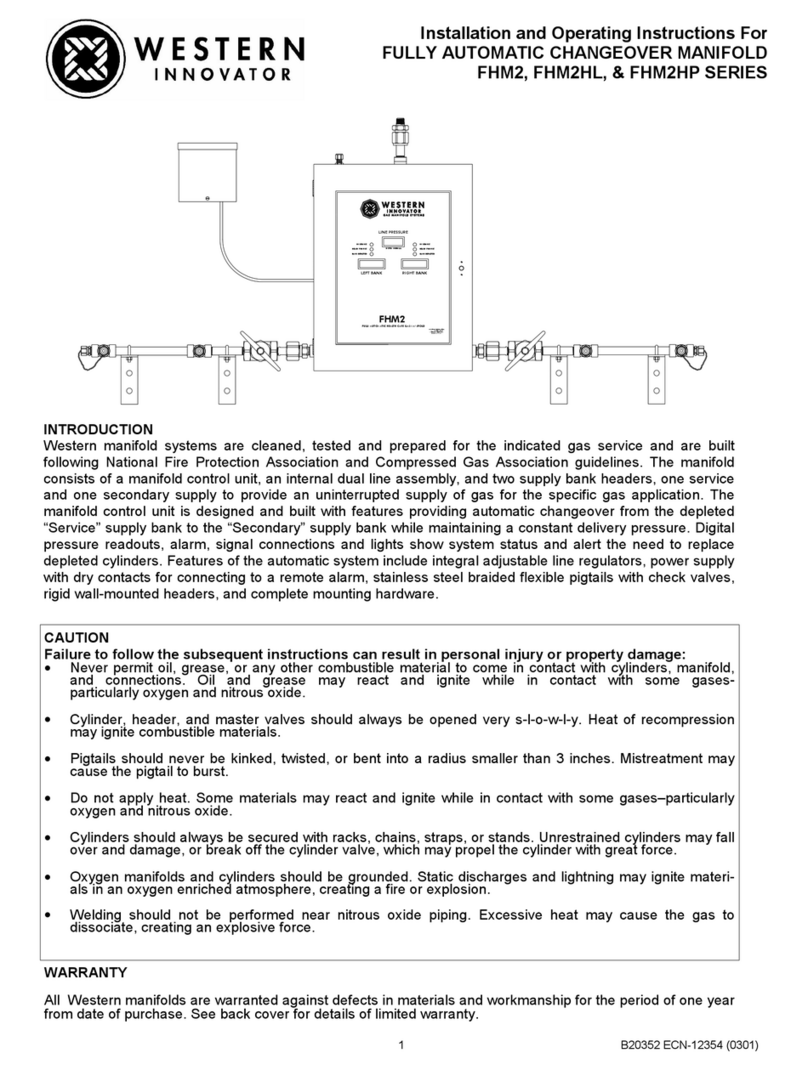
Western Innovator
Western Innovator FHM2 SERIES Installation and operating instructions
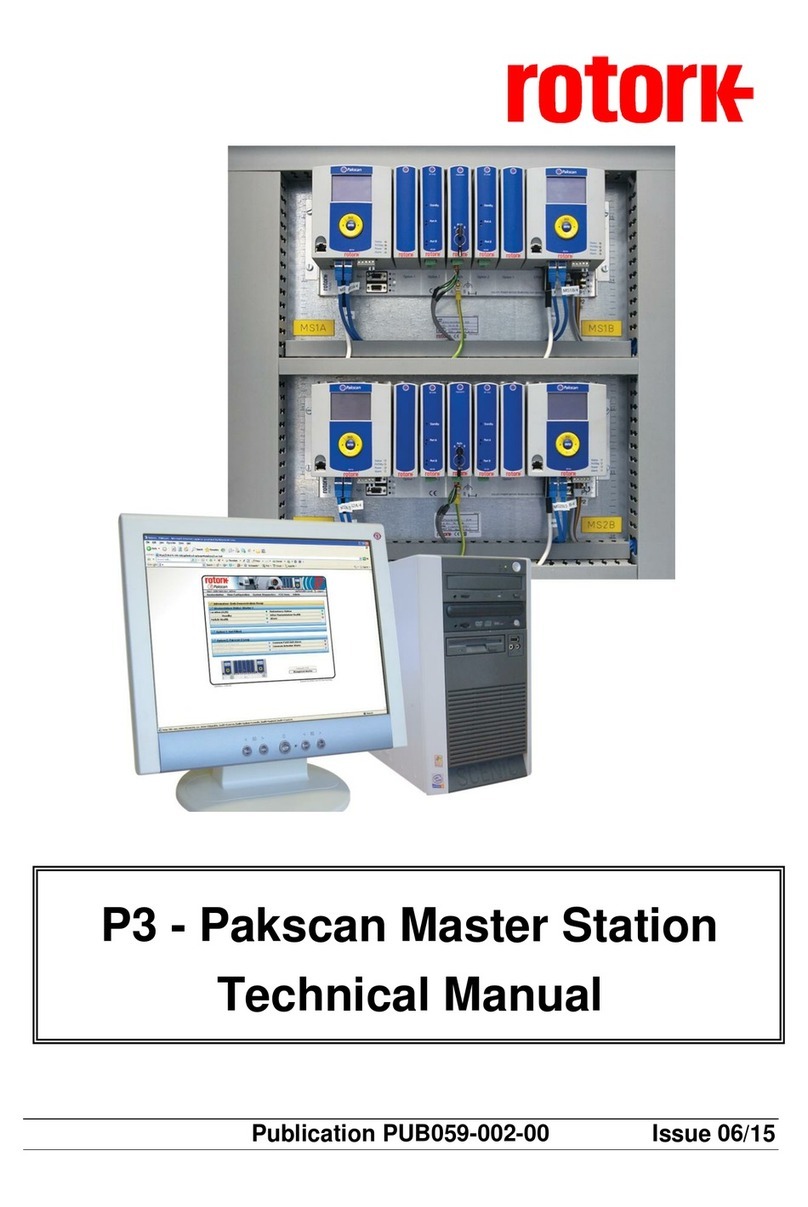
rotork
rotork p3 Technical manual

Ingersoll-Rand
Ingersoll-Rand Xe-145M instruction manual

